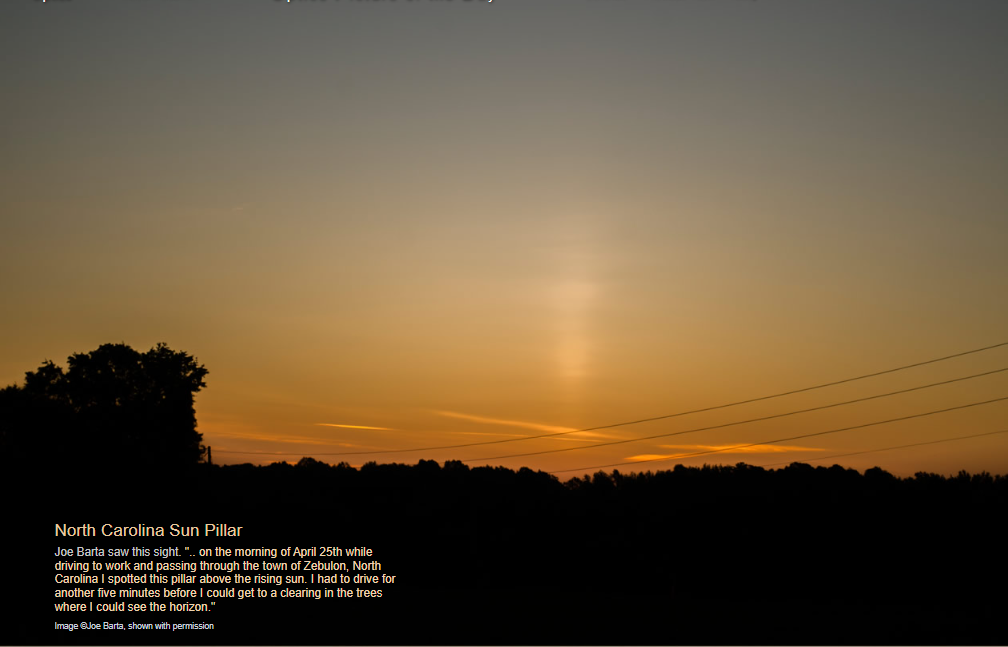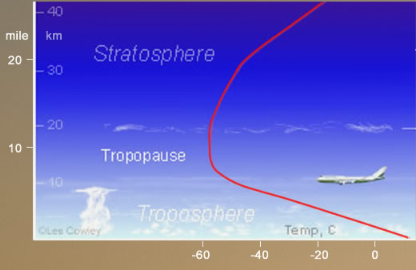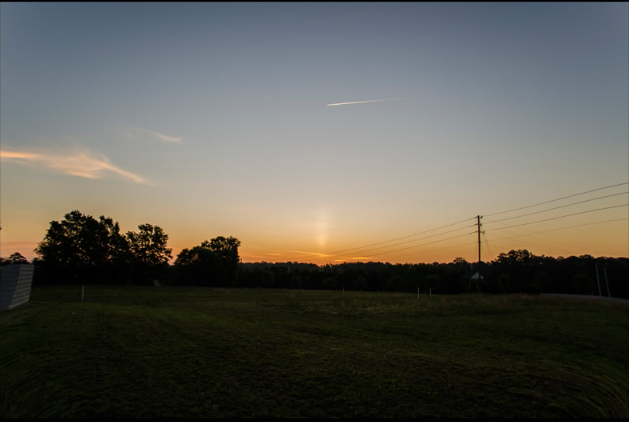North Carolina Sun Pillar - OPOD
North Carolina Sun Pillar: A Spectacular Atmospheric Phenomenon
Have you ever witnessed a breathtaking sight in the sky that left you in awe? Joe Barta, a lucky observer in North Carolina, had one of those moments on the morning of April 25th. As he was driving to work through the town of Zebulon, he noticed a remarkable pillar above the rising sun. In order to fully appreciate this captivating phenomenon, he had to drive for another five minutes until he reached a clearing in the trees where the horizon was visible. Luckily, he managed to capture this extraordinary event and shared it with the world.
The Science Behind Sun Pillars
Sun pillars, like the one witnessed by Joe Barta, are a type of atmospheric optical phenomenon that occurs when sunlight interacts with ice crystals in the atmosphere. These crystals can be found in higher altostratus and cirrus clouds or haze, typically located between 3 to 6 miles above the Earth's surface. At these altitudes, the temperature drops below zero Celsius, creating the perfect conditions for the formation of ice crystals.
The ice crystals responsible for sun pillars are often plate-like in shape, resembling wobbly plates or irregular hexagons. While some crystals may have more regular hexagonal structures, the majority are larger and less symmetrical. When sunlight from a low-lying sun encounters these ice crystals, it reflects off their large hexagonal faces both externally and internally.
The Illusion of a Vertical Pillar of Light
As the sunlight reflects off the millions of ice crystals, it creates glints or flashes of light. These glints appear as a vertical pillar of light extending upwards from the sun. However, appearances can be deceiving. The vertical shaft of light is merely an illusion created by our perception. In reality, there is no physical pillar of light ascending into the sky.
Exploring Sun Pillars in Depth
To fully appreciate the beauty and complexity of sun pillars, it is essential to delve deeper into their characteristics and the factors that influence their appearance:
-
Crystal Formation: Sun pillars are formed when light interacts with plate-like ice crystals in the atmosphere. These crystals can be irregular in shape and size, contributing to the unique patterns observed in sun pillars.
-
Sun Angle: Sun pillars are more likely to be visible during sunrise or sunset when the sun is low on the horizon. The angle of the sunlight plays a crucial role in creating the conditions necessary for the reflection and refraction of light by the ice crystals.
-
Weather Conditions: The presence of high-altitude clouds, such as altostratus and cirrus clouds, is often associated with sun pillar sightings. These clouds contain the ice crystals that interact with sunlight to create the optical phenomenon.
-
Location and Viewing Perspective: Observing a sun pillar requires a clear view of the horizon, free from obstructions such as trees or buildings. Joe Barta's experience highlights the importance of finding a suitable vantage point to fully appreciate this awe-inspiring sight.
Capturing the Beauty of Sun Pillars
Photographing sun pillars can be a challenging yet rewarding endeavor. To capture these stunning phenomena, consider the following tips:
-
Timing: Plan your photography session during sunrise or sunset when the sun is low on the horizon, increasing your chances of witnessing a sun pillar.
-
Composition: Look for interesting foreground elements to include in your composition, such as trees or structures, to add depth and context to your photograph.
-
Exposure Settings: Experiment with different exposure settings to capture the subtle details and colors of the sun pillar. Bracketing exposures can help ensure you capture the full dynamic range of the scene.
-
Post-Processing: Use photo editing software to enhance the contrast, colors, and overall impact of your sun pillar photograph. However, remember to maintain the integrity of the original scene and avoid excessive editing.
Conclusion
The North Carolina Sun Pillar witnessed by Joe Barta serves as a reminder of the remarkable beauty and complexity of atmospheric optics. These captivating phenomena, created by the interaction of sunlight with ice crystals in the atmosphere, continue to inspire and awe observers worldwide. By understanding the science behind sun pillars and honing our photography skills, we can capture and share these breathtaking moments with others, fostering a deeper appreciation for the wonders of our natural world. So, keep your eyes on the sky, and who knows, you might be the next lucky witness of a mesmerizing sun pillar.

North Carolina Sun Pillar
Joe Barta saw this sight. ".. on the morning of April 25th while driving to work and passing through the town of Zebulon, North Carolina I spotted this pillar above the rising sun. I had to drive for another five minutes before I could get to a clearing in the trees where I could see the horizon."
Image ©Joe Barta, shown with permission

Climb and the atmosphere quickly cools. Worldwide at 3 to 6 miles high the air is already below zero Celsius.
This is the height of higher altostratus and cirrus cloud or haze composed of supercooled water droplets or ice crystals. The latter are the stuff of halos including sun pillars.

Wobbly plate-like crystals form sun pillars. They might be regular hexagonal plates like those at right. They are more likely to be large, less regular and imperfect.
Rays from a low sun reflect off their large hexagonal faces both externally and internally.
The reflection glints from millions of crystals appear as a vertical pillar of light.
Appearances deceive - there is no vertical shaft of light, that is an illusion.

Note: this article has been automatically converted from the old site and may not appear as intended. You can find the original article here.
Reference Atmospheric Optics
If you use any of the definitions, information, or data presented on Atmospheric Optics, please copy the link or reference below to properly credit us as the reference source. Thank you!
-
<a href="https://atoptics.co.uk/blog/north-carolina-sun-pillar-opod/">North Carolina Sun Pillar - OPOD</a>
-
"North Carolina Sun Pillar - OPOD". Atmospheric Optics. Accessed on November 26, 2024. https://atoptics.co.uk/blog/north-carolina-sun-pillar-opod/.
-
"North Carolina Sun Pillar - OPOD". Atmospheric Optics, https://atoptics.co.uk/blog/north-carolina-sun-pillar-opod/. Accessed 26 November, 2024
-
North Carolina Sun Pillar - OPOD. Atmospheric Optics. Retrieved from https://atoptics.co.uk/blog/north-carolina-sun-pillar-opod/.